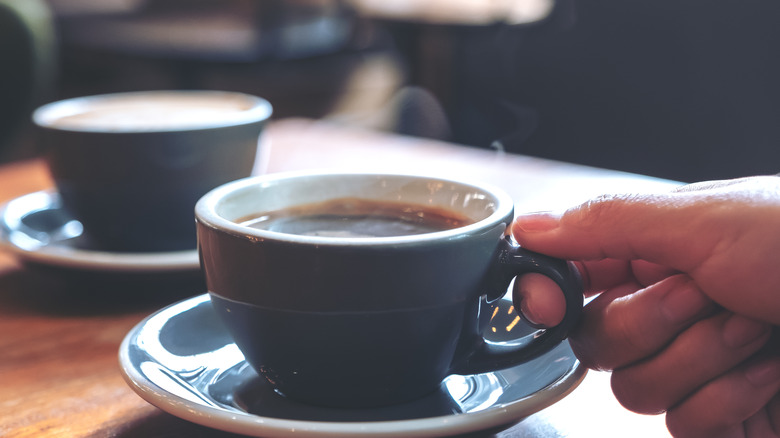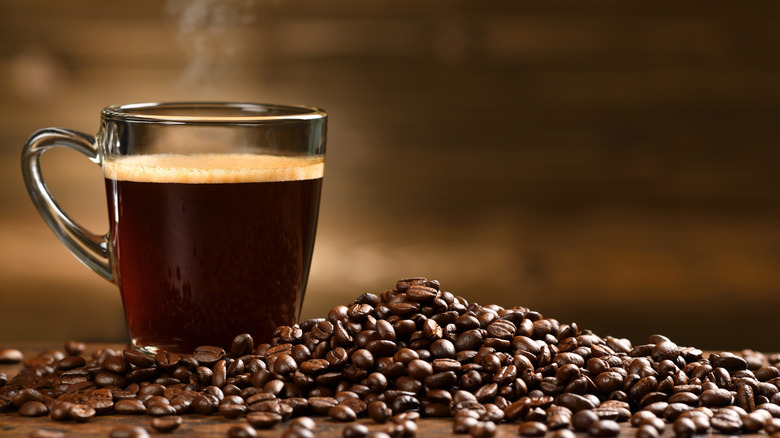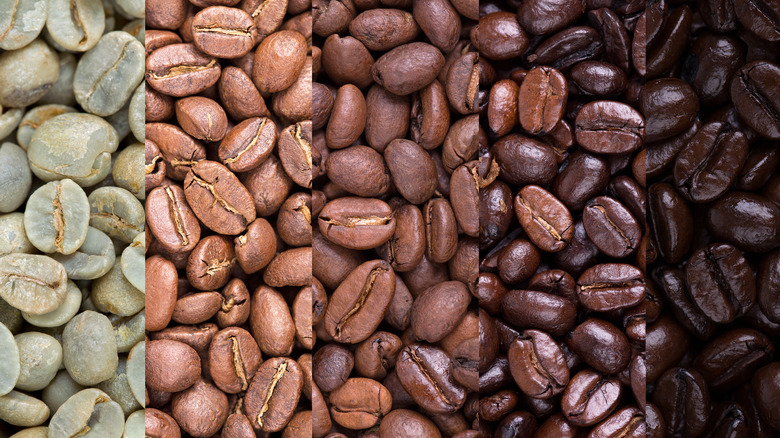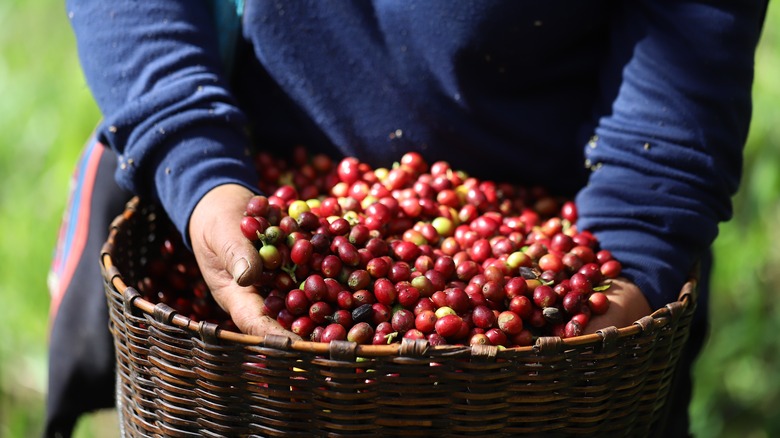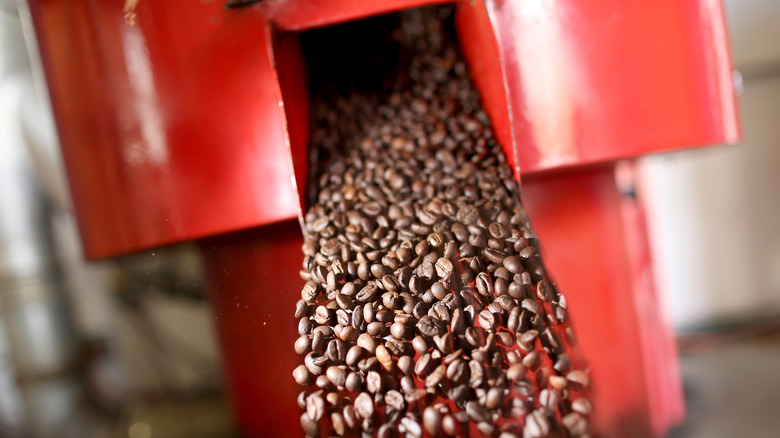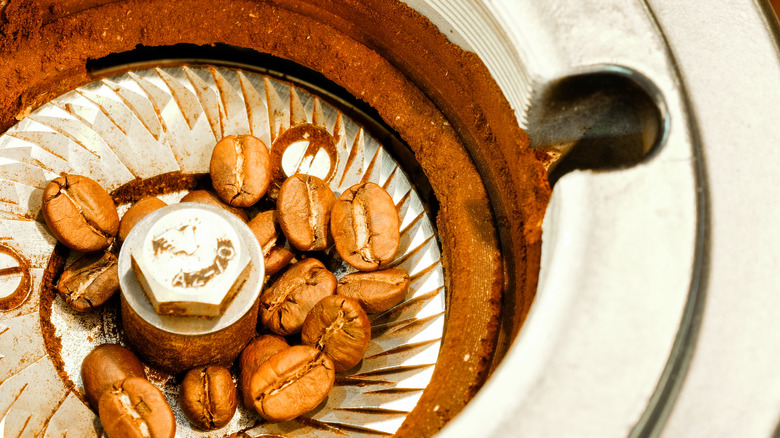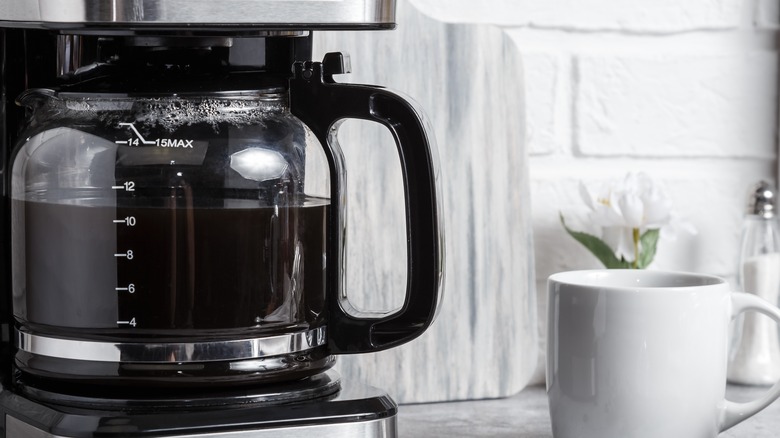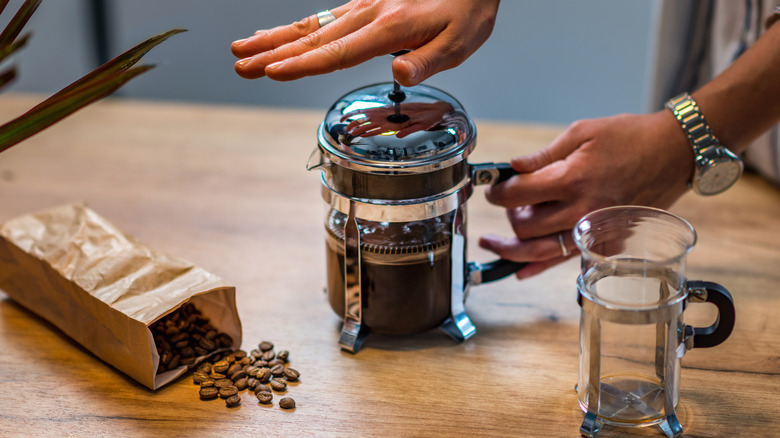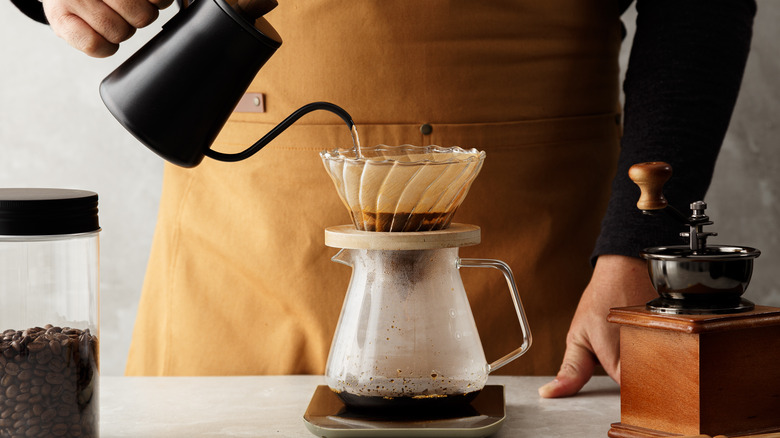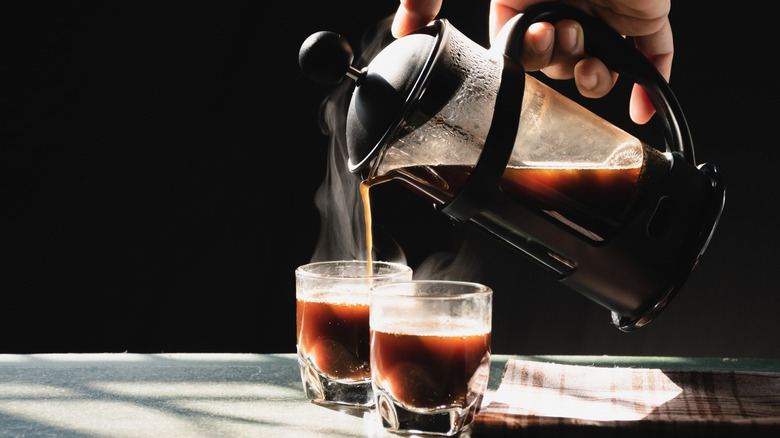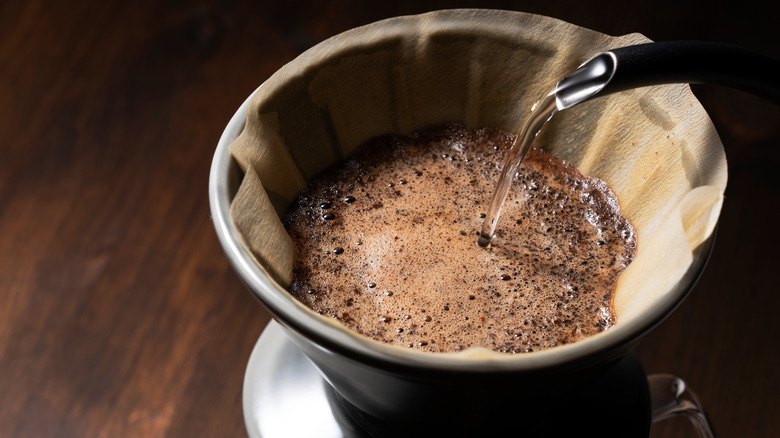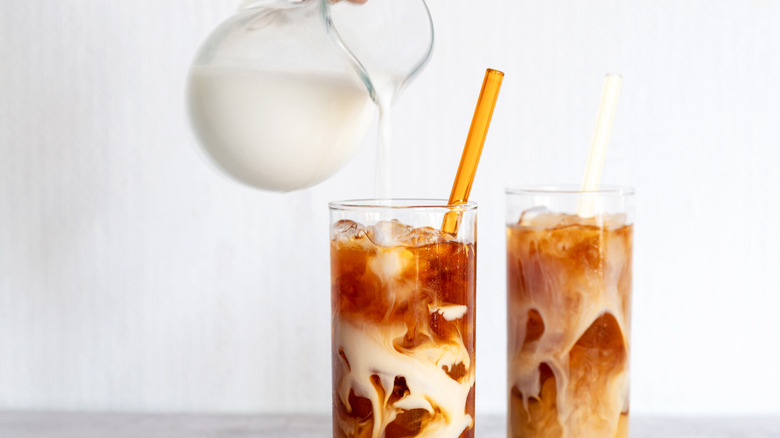11 Tips For A Stronger Cup Of Coffee, According To Margaret Nyamumbo From Shark Tank - Exclusive
In between the life-and-death battles in Marvel's blockbuster "Thor," a Norse god sips coffee for the first time and wigs out. This message needs no interpreting: a strong cuppa is Valhalla-level good.
Thor's reaction is doubtless what we all long for when we stumble into our kitchens in the morning in a groggy search for robot fuel. But how? To gather tips for a stronger cup of coffee, Tasting Table turned to Margaret Nyamumbo. You might recognize Nyamumbo as the owner of a Shark Tank food company. If not, know that you're in good hands. Nyamumbo gleaned her knowledge from a lifetime immersed in the world of java. As a child on her grandfather's coffee farm, she told Tasting Table, "What I observed [was] that women did the majority of work on the farms, about 90%, but they didn't always get compensated or recognized."
Today, every step of the coffee supply chain is vital to Nyamumbo. Her company, Kahawa 1893, offers sustainable, traceable beans sourced from women-owned farms — you can tip your coffee farmer directly via a bar code you'll find on the bag. The former Wall Street investment banker confessed to drinking tea while growing up; New York City turned her into a bean juice convert. In what follows, Nyamumbo takes us through all the variables that affect optimal coffee strength, from bean origin, processing method, and roast to the brewing process. Welcome to the master class that your morning self has been waiting for.
1. A dark roast doesn't make for a stronger brew
A dark French roast tastes like the Hulk of coffees, but if we're getting nitpicky, the type of roast matters. The darker the roast, the less caffeine you're in for. Think of coffee beans like steaks. "With coffee, 'rare' means it's a light roast. 'Medium' means it's a medium roast, and 'well done' means it's a darker roast," Margaret Nyamumbo explained. "When you're roasting coffee, the darker you go, you're getting more of the sugars carmelizing, you're getting a lot of the sweetness coming out."
Dark roast will give you the bold, smokey flavors you may associate with 'strength.' It comes, however, at the cost of other tastes and a bit of your morning pick-me-up, too. "The more you roast, it's almost like a vegetable. The more you boil them, you lose the flavors," she told us. "If you want to get scientific, the same coffee bean roasted light has more caffeine than when it's roasted dark." Differences in caffeine levels, she stipulated, are minimal.
Instead of picking a roast for strength, pick it to match how you take your morning cuppa. "Medium roast is one of my favorites because you get a really good balance of the sugars coming out, but you also get an expression of where the coffee comes from," said Nyamumbo. That makes it delicious when enjoyed black. On the other hand, the "bold" flavors of a dark roast combine well with milk or as espresso.
2. For maximum strength, give a light roast a try
For optimal caffeine intake, try a light roast coffee. As Margaret Nyamumbo recounts, "I would say a light roast is your best bet for getting a really strong coffee, unexpectedly." For light roast novices, she suggests using a full-immersion type of coffee maker. Full immersion won't filter out the bean's oils and will produce a cuppa with a "heavier" body, more similar to the medium and dark roast coffees you may be used to.
"Kind of like wine, right? When you look at a red wine versus a white wine, you're going to get a little bit more body from a red wine just because of the skins," the Kahawa 1893 founder explained.
Considering the origin of your coffee is also vital when opting for a light roast. Per Nyamumbo, if you know you like a certain origin as a darker roast, you'll likely appreciate it as a light roast, too. On the other hand, if you're looking for a truly unique light roast experience, she suggests trying an Ethiopian or Kenyan blend, whose distinct taste profiles are favored by coffee savants. "[If] you want to really experience ... why coffee connoisseurs are fascinated with light roasts, I would recommend going with those origins, " Nyamumbo told Tasting Table. "Once they go light, it's hard for them to go back. You can quote me on that!"
3. For enhanced flavors, go naturally processed
You've picked your optimal coffee based on roast and origin. What else should you keep in mind when hunting for the perfect variety of beans? The ways coffee beans are processed – i.e., how coffee beans are extracted from their cherries — may not influence caffeine content significantly. It will, however, affect the nuances of flavors, which is a determining factor of strength. For enhanced flavors, Margaret Nyamumbo of Kahawa 1893 recommends looking for naturally processed instead of wet-processed beans, which is how the majority of beans are processed.
Here's what you need to know about the two processing methods, per Nyamumbo. During wet processing, coffee beans hang out in the sun alone after being extracted from their cherries using water. During natural processing, coffee beans dry out inside the cherry. That's key.
"When [the bean is] drying out in the sun, the sweetness from the sugars from the cherry go into the coffee bean, and that really counteracts the natural acidity," Nyamumbo detailed to Tasting Table. The resulting, dried-out coffee bean possesses more satisfying flavors than a wet-processed bean might. As she tells us: "You're getting a sweeter, less-acidic bean, and it takes on very interesting tastes depending on the degree to which you ferment it."
4. Your beans should be recently roasted
Oils are where coffee's superpower comes from, and we're not talking about adding olive oil to coffee à la Starbucks. "Think of [coffee oils] like essential oils; they hold the flavor," Margaret Nyamumbo told Tasting Table. "[The] things that you want out of coffee are held in oils."
A dark roast is roasted until oils start to come out and is the exception to this rule. Still, you don't want too much oil. If you open a medium or light roast bag and the beans are oily, that's a red flag. As Nyamumbo advised us, that is likely a sign that the beans are past their prime and won't give you the kind of strong flavors that would make a Norse god go bonkers.
How recently roasted should your coffee beans be? Nyamumbo will give them "up to three months," depending on their quality. Again, a wine analogy is appropriate. Some wines are best enjoyed young. Others thrive for years. The same, to an extent, is true for beans. Our coffee connoisseur recommends prioritizing quality beans over beans roasted yesterday. Specifically, look for hand-harvested, high-altitude varieties. "I would say [choose] high-altitude beans like those that grow in Africa and the ones that are hand-harvested because of the climate and because of the care that they get," Nyamumbo suggested. "These coffees have so much flavor that, within a year, they still hold their flavor ... That's something most people don't talk about; that is the nuance."
5. The grind does matter
Let's recap, shall we? On your quest for a strong brew, you've found recently roasted, hand-harvested, naturally processed beans. None of that matters if the grind isn't right. Consider three factors for the grind. First, says Margaret Nyamumbo, "If you want the best shot at getting the best coffee experience, getting a whole bean coffee and grinding it right before you brew it will give you the best-tasting coffee." Do that, and you avoid buying ground beans that may have been languishing for months, slowly losing their flavor.
Second, for optimal strength, adjust your grind according to the brewing method. As Nyamumbo explained, the grind will impact the extraction, and extraction is directly related to the strength of your coffee. Is your grind too coarse? You're risking sub-optimal extraction and a considerably weaker jitter juice. Is your grind too fine? You might be clogging up the extraction process.
Third, invest in a quality type of coffee grinder. Nyamumbo strongly suggests investing in a burr grinder, which will give you a uniform coffee powder and, therefore, a stronger brew overall. Stay away from blade grinders, which produce unevenly ground chunks. "Similar to when you're putting something in the oven, and you're cooking something, you have some potatoes that are cut half, some full, they're all going to cook at different times, which you don't want," Nyamumbo told us. "That's why you want to make sure you have an even grind extraction throughout."
6. Learn the best water-to-coffee ratio for brewing method
If your desire for strong coffee has turned into Sisyphus rolling a boulder up a hill, your preferred brewing method might not allow for an optimal water-to-bean ratio. An American automatic drip coffee, for example, is usually one part coffee to 15 parts water, according to Margaret Nyamumbo of Kahawa 1893. That's not anywhere near the strength that other brewing methods offer.
The equation is simple: more coffee beans and less water mean a stronger cup. With methods like French Press or pour-over, you can manually adjust the ratio of water to beans and experiment. For maximum strength, however, consider staying away from hot brews altogether. Instead, make a cold brew for a cuppa that is three times stronger than a drip coffee — or a ratio of about one part coffee to four or five parts water.
"You can dilute it with milk, or you can actually just drink it straight up," Nyamumbo told us. Though, she doesn't suggest doing the latter. "You want to always dilute it. You don't want to have a coffee shock from too much caffeine," she stipulated. For those of you taking notes, when you do add liquids to your cold brew, the optimal coffee-to-liquid ratio is around one to eight.
7. Aim for a three to four minute bean-to-water contact
Making coffee may not be as exact a culinary art as baking or chocolate making, but brewing time does matter. As Margaret Nyamumbo of Kahawa 1893 posited, "Obviously, the longer the contact [between coffee grinds and water], you're going to extract more out of it, which makes for a stronger coffee." Right — sort of. It's always possible to have too much of a good thing. "If you leave it for too long, you're going to start to extract undesirable flavors."
The sweet spot depends on your brewing method of choice. Nyamumbo recommends around four minutes for a French Press and between three and four minutes for a pour-over. Fair warning: a pour-over isn't beginner-level stuff. Instead of the hands-off full-immersion brewing experience that the French Press offers, if you go the pour-over route, you'll be imitating drip-brewing, but manually. Your success or failure will depend on your pour rate and how steady your hand is.
For better control, pour gently. "You really are guiding the contact because depending on how quickly or slowly gently you pour, it affects the duration [of water contact]," Nyamumbo told us. A water kettle that allows for a slower, delicate pour will make your life easier. If you don't, water and beans might not get enough one-on-one time, leaving you with a weaker-than-desired cup.
8. Keep your water temperature optimal
Drip coffee makers and espresso machines take water temperature out of the equation altogether. If your brewing method does allow you to control temperature, however, pay attention to it. As Margaret Nyamumbo asked us to consider, "When you're making a strong coffee, and you have the right amount of water, you want to make sure the contact time is enough, but then, this might be the most important of all of them, is the temperature right?"
Excluding cold brew — which entails vastly different extraction times than hot brewing methods — the general rule of thumb is that hotter water makes for strong go juice. "Depending on how strong you want the coffee, if you want it really strong, you want it to be as hot as possible," she told us. Don't use boiling water, though. Like too much water-to-bean contact, using water that's too hot will extract unpleasantly "bitter" taste profiles from your beans, according to Nyamumbo.
Here's where it gets tricky. Optimal coffee strength is achieved via a very specific temperature range. Simply put, "near-boiling, but not boiling." If we're getting into the weeds, you've got a 12-degree Fahrenheit range for optimal caffeine extraction. Water (at sea level) boils at 212 degrees Fahrenheit. As per Nyamumbo, "If you go below 200, you're not going to get the strength out of the coffee that you want."
9. A French Press preserves natural oils for a fuller flavor
Brewing a French press allows you to control most of the variables that go into creating a strong cup of joe, including the temperature of your water (just before boiling), your water-to-coffee interaction time (ideally four minutes for this brewing method), and grind (for a French Press, you'll want a courser grind, says Margaret Nyamumbo).
Nyamumbo is a self-declared French press convert for another reason, too. As per the Kahawa 1893 founder, it's a brewing method that enhances flavors and makes for a stronger-tasting cup. "I went through the whole process where I was in love with the V60 — the pour-over, and now I'm in love with the French press," Nyamumbo told Tasting Table. "The reason for that is with the French press, because there's no paper filter, you get the oils [which] makes the coffee feel fuller, so you're getting a fuller, bolder flavor." There are many definitions of what a strong coffee actually means, but most can agree that flavor plays a large part.
10. Pour-over coffee gives more manual control
Like a French press, pour-over coffee will give you optimal manual control over strength-inducing variables in the coffee-making process. Aim for near-boiling water and a three to four-minute water-to-coffee interaction time, as guided by a gentle pour. While a French press will benefit from courser grinds, you'll want a "regular or finer grind" for this brewing method, says Margaret Nyamumbo of Kahawa 1893.
When is coffee made via pour-over better than a French press-produced rocket fuel? Using a pour-over coffee maker is better when filtering out oils is to your advantage. Specifically, Nyamumbo recommends making a stronger cup with light-roasted beans and a pour-over. "I like to enjoy pour-overs with really light coffees when I really want that expression and that very delicate taste, because the paper filter filters out the oils," Nyamumbo explained. According to her, less oil equals more nuanced flavor. "The light roast, because it's lacking in oils, we perceive that delicateness even more than we would with the oils."
11. A cold brew could be the answer to your prayers
Because of its ideal coffee-to-water ratio (one to four), a cold brew is naturally going to give you a caffeine high. To get a cold brew right, make sure the grind is course. "You don't want it to be too fine because that affects the speed of extraction," per Margaret Nyamumbo. Also, "Also, it's going to be really tough to filter because it's going to clog."
What else affects the quality of a cold brew? The correct roast will depend on "what you're going for," according to Nyamumbo. Like with hot coffees, Nyamumbo suggests dark roasts for milk-diluted brews. If black coffee is your go-to, head towards lighter roasts. If you want to lean into a lighter roast's acidity, try adding citrus to it. "One of my favorite things to do with cold brews, especially when they're lighter roast, is adding lemonade to it," Nyamumbo told us. "The light roast has a little more acid and kick when you put them together. It's such a refreshing taste."
Beyond that, think of cold brewing as the Wild West of coffee making; a cold brew doesn't actually require water at all. Try brewing your coffee in coconut milk instead, or add cinnamon for a spice-infused experience. "Cold brew can become very creative, right?" said Nyamumbo. "I think with cold brew, the rules of coffee are a little bit flexible."
Static Media owns and operates Tasting Table and Mashed.
